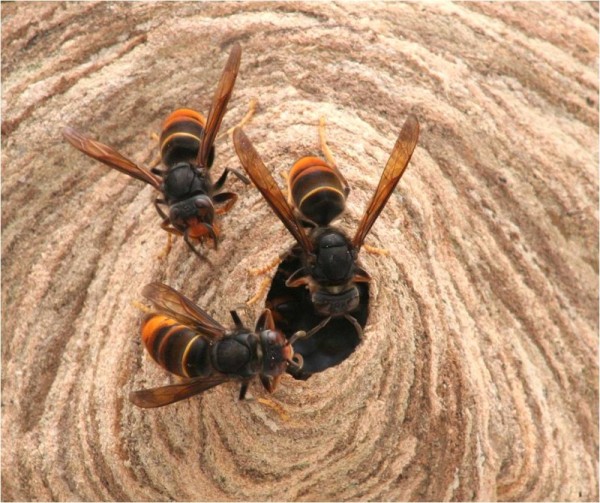Every year the Non-native Species Secretariat and the National Bee Unit receive many reports of suspected Asian hornets. Many of these reports do not come with any means to identify them, other than a written description. However, without a photograph or sample, it is not possible to be sure of the identification of a sighting. This page will help outline some of the ways in which you can go about obtaining a sample so that we can better identify what you have seen. If you are unsure about what type of insect you have seen, you should make an effort to photograph the hornet and report it as outlined below.
It is vital that in the spring, when Asian hornet foundresses are on the wing and sighted by someone, they are not allowed to escape. Please familiarise yourself with what the Asian hornet, and common misidentified insects, look like and to help you the Asian hornet fact sheet in English and Welsh can be downloaded. If you spot one, please make every effort to try and capture/ kill it to prevent it from flying off. and then notify as outlined below.

How do I catch Asian Hornets?
Great care should be taken when trying to obtain an Asian hornet specimen. Please ensure that you wear appropriate personal protective equipment (such as a bee suit) where appropriate or carry out the procedures as safely as possible.
Catch an Asian hornet using an insect/ entomological net or children’s fishing net
When using a butterfly or children’s fishing net to catch an Asian hornet it is best to approach the hornet from underneath with the net and make a large upward sweeping motion and finally slamming the opening of the net facing toward the ground so that the hornet cannot escape. You can then kill the hornet safely by placing it in a container and freezing it or by standing on it.
Catch an Asian hornet using a tennis racket or electric fly swatter
Tennis rackets and electric fly swatters can be used to knock down or temporarily stun Asian hornet to the ground. You will need to give the Asian hornet a fair whack to bring it to the ground and daze it. Tennis rackets and electric fly swatters will not kill the hornet and therefore it will need to be killed by some other means. The safest way is to stand on it and then put it in a container and freeze it overnight.
Photograph the predating/ foraging Asian hornet
Photographs can be used as evidence to record your sighting of Asian hornets. Images should be clear and in focus so that whoever is charged with identification of the image can do so easily. Images taken from a distance, where Asian hornet features and colouration cannot be seen clearly are not helpful. Photographs should then be reported, using the email address outlined in the 'What do I do once I have caught an Asian hornet?' section. If the photograph is deemed positive, the National Bee Unit will contact you to arrange a visit to the location by a Bee Inspector.
Trap an Asian hornet sample
You can hang out monitoring traps as a surveillance measure for detecting the presence of Asian hornet in your garden/ apiary. It is important that we do not trap our native and beneficial insects and that is why we have designed a monitoring trap that will not kill the insects. To make one please see these leaflets:
What do I do once I have caught an Asian hornet?
Once you have caught an Asian hornet it should be killed by either standing on it or by placing it in a freezer for 24 hours. Once dead sightings should be sent in via the links below:
- Asian Hornet Watch app for iPhone (external link)
- Asian Hornet Watch app for android (external link)
- Online recording form (external link)
You can also email us to report an Asian hornet sighting. Please send a photograph and location details.
The sample should be retained and kept in the freezer as we may require it later on.
Where do I send samples and what qualifies as a sample?
In the first instance, a photo or a photo of the sample you have caught should be sent to the alert non-native email. If we require the sample later on, either a Seasonal Bee Inspector will come and collect it or it can be sent to the National Bee Unit laboratory. When sending in samples, please use a breathable (e.g. cardboard), securely packaged and sturdy container. Provide as much detail as possible about the sample, where it was found and contact details for yourself should we need to get further information and send the sample to:
NBU laboratory, Lab 02G06, York Biotech Campus, Sand Hutton, York, YO41 1LZ
